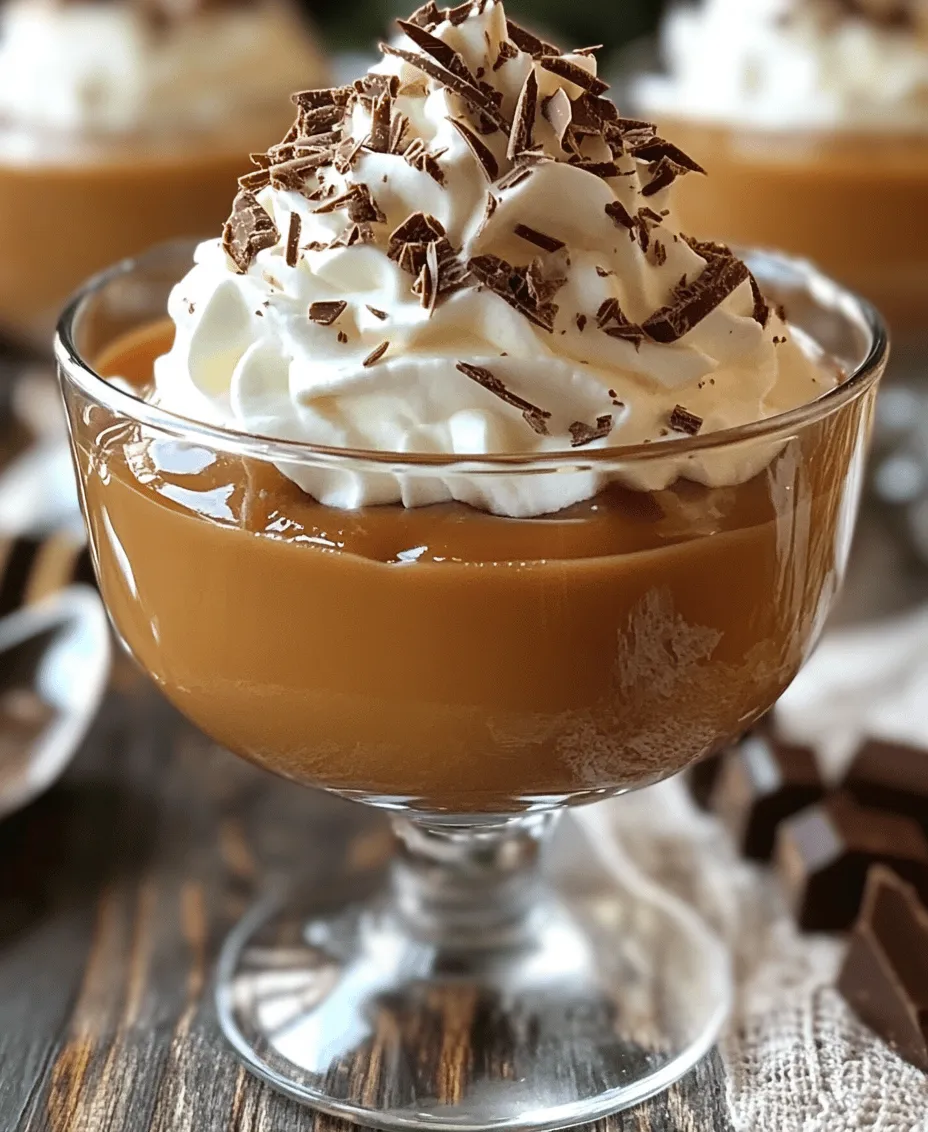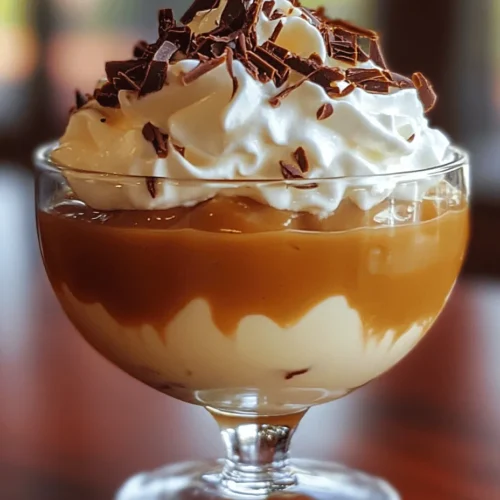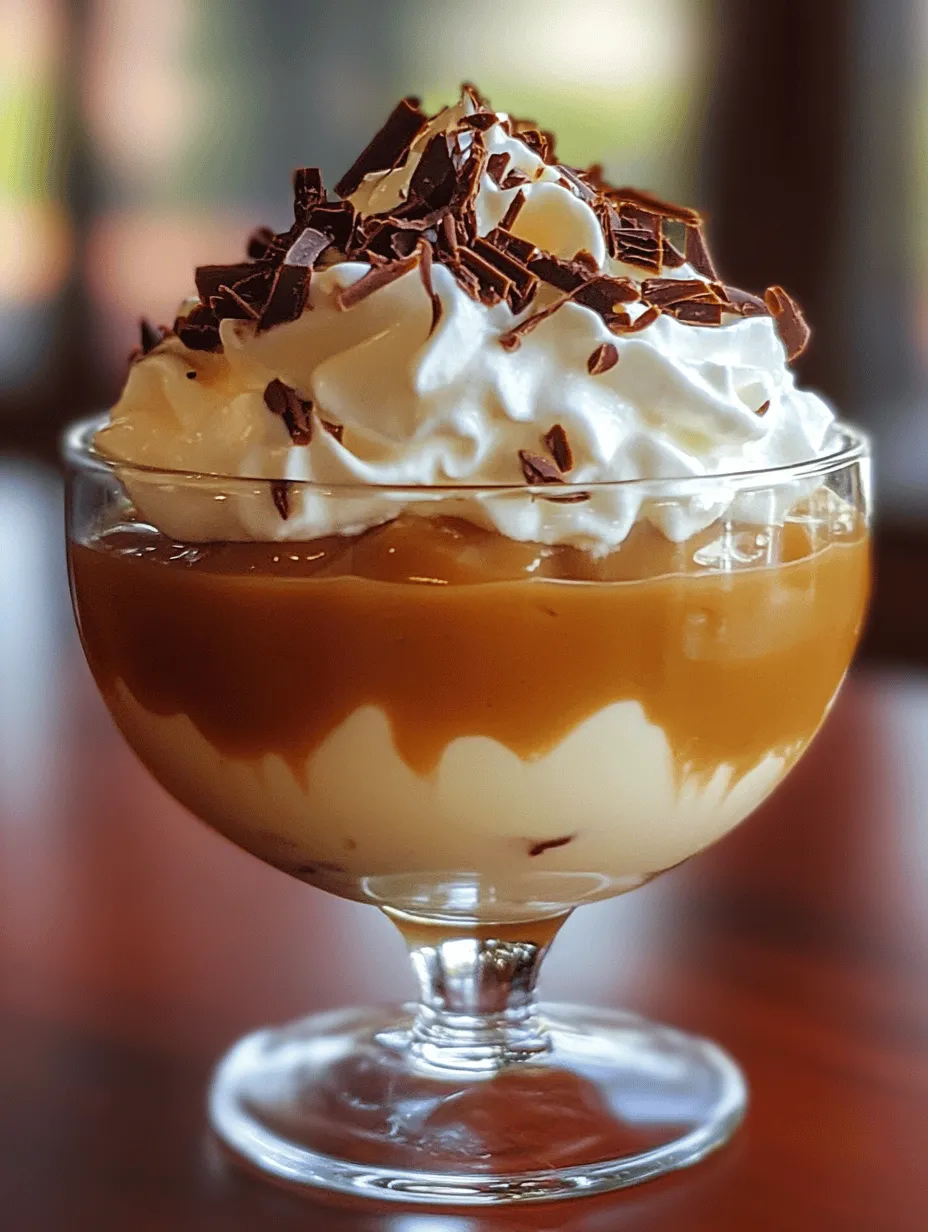Introduction
In a world brimming with instant desserts and store-bought treats, there’s something truly special about the allure of homemade desserts. They evoke warmth, nostalgia, and an unparalleled sense of comfort that can only be achieved in your own kitchen. One such classic that has stood the test of time is butterscotch pudding—a creamy, dreamy delight that offers a perfect balance of sweetness and indulgence.
Butterscotch pudding is more than just a dessert; it’s a comforting hug in a bowl, reminiscent of childhood memories and family gatherings. Its rich, buttery flavor combined with a velvety texture makes it a favorite among dessert lovers of all ages. The beauty of this pudding lies not only in its taste but also in the simplicity of its preparation. When made with quality ingredients, the result is an exquisite treat that elevates any meal, be it a casual dinner or a festive celebration.
In this article, we will delve into the world of butterscotch pudding, exploring its history, the essential ingredients that contribute to its luscious flavor, and the step-by-step process to create this delightful dessert from scratch. Whether you’re a seasoned home cook or a novice in the kitchen, our detailed guide will help you master this timeless recipe, ensuring a perfect outcome every time.
The History of Butterscotch Pudding
Butterscotch itself has a rich history that dates back to the early 19th century in England. The term “butterscotch” is believed to have originated from the process of “scotching,” which refers to the method of scoring or cutting a layer of sugar during the cooking process to create a brittle candy. The combination of brown sugar and butter, along with a hint of salt, resulted in a delectable candy that would later inspire the creation of butterscotch pudding.
Over the years, butterscotch has evolved from a simple candy to a key ingredient in various desserts, with its sweet and buttery flavor becoming synonymous with comfort food. Butterscotch pudding emerged as a beloved dessert, quickly becoming a staple in many households. It offers a delightful contrast to other puddings, such as chocolate or vanilla, by providing a unique depth of flavor that can be further enhanced with the addition of spices or toppings.
Culturally, butterscotch pudding holds a special place across different cuisines. In the United States, it often graces the tables of family gatherings and holiday celebrations, while in the United Kingdom, it is frequently served as a comforting dessert after a hearty meal. The timeless appeal of butterscotch pudding continues to resonate with dessert enthusiasts today, making it a must-try recipe for anyone looking to indulge in a classic treat.
Understanding the Ingredients
To create a truly exceptional butterscotch pudding, it is essential to understand the role of each ingredient in the recipe. The quality of these components significantly impacts the final flavor and texture of the pudding. Let’s break down the key ingredients that come together to create this creamy delight.
Brown Sugar: Types and Benefits
Brown sugar is the star of butterscotch pudding, providing its signature flavor and color. There are two main types of brown sugar: light and dark. Light brown sugar contains a smaller amount of molasses, resulting in a milder flavor, while dark brown sugar has a higher molasses content, giving it a richer and more robust taste. For butterscotch pudding, using dark brown sugar can enhance the depth of flavor, making the pudding even more indulgent.
Cornstarch: Role as a Thickening Agent
Cornstarch is a vital ingredient in this pudding recipe, acting as a thickening agent that gives the pudding its creamy, spoonable consistency. When heated, cornstarch absorbs moisture and swells, creating a smooth and silky texture. For best results, ensure that the cornstarch is mixed with a bit of cold milk prior to adding it to the hot mixture to prevent clumping and achieve a velvety finish.
Salt: Enhancing Flavors
Though it may seem counterintuitive to add salt to a sweet dessert, a pinch of salt is crucial for enhancing the overall flavor of butterscotch pudding. Salt acts as a flavor amplifier, balancing sweetness and bringing out the rich buttery notes of the pudding. It’s essential to use the right amount; too much can overpower the sweetness, while too little may leave the pudding tasting flat.
Whole Milk: Importance of Creaminess in Pudding
Whole milk is the foundation of butterscotch pudding, providing the creamy texture that makes this dessert irresistible. The higher fat content in whole milk helps create a rich mouthfeel, while also allowing the flavors to meld beautifully. For an even silkier pudding, consider substituting a portion of the whole milk with heavy cream, but be mindful of the added richness.
Egg Yolks: Contributing to Richness and Texture
Egg yolks play a crucial role in the pudding, contributing to its richness and silky texture. They act as a natural emulsifier, helping to bind the ingredients together while adding a luxurious mouthfeel. When incorporating the egg yolks into the mixture, it’s important to temper them by gradually adding hot liquid to prevent curdling, ensuring a smooth and creamy result.
Unsalted Butter: Flavor and Finish
Unsalted butter is another key ingredient that elevates the flavor of butterscotch pudding. The butter adds a luscious richness and enhances the overall taste of the dessert. Using unsalted butter allows you to control the saltiness of the pudding, ensuring that it perfectly complements the sweetness of the brown sugar.
Vanilla Extract: Enhancing Overall Taste
Vanilla extract is the finishing touch that brings all the flavors together in butterscotch pudding. The warm, aromatic notes of vanilla enhance the sweetness and depth of the pudding, making each bite a delightful experience. For the best flavor, opt for pure vanilla extract rather than imitation varieties, as the quality of the extract can significantly impact the final taste.
Whipped Cream and Garnishes: Final Touches for Presentation
To elevate your butterscotch pudding, consider serving it with a dollop of homemade whipped cream. The light, airy texture of whipped cream contrasts beautifully with the rich pudding, creating a harmonious balance. Additionally, garnishing with a sprinkle of shaved chocolate, crushed toffee, or a dusting of cocoa powder can add visual appeal and an extra layer of flavor.
Tips for Sourcing High-Quality Ingredients
To achieve the best results with your butterscotch pudding, sourcing high-quality ingredients is essential. Look for organic or artisanal brands of brown sugar to ensure a robust flavor. When it comes to dairy, choose whole milk and unsalted butter from reputable sources, ideally local farms or high-quality grocery stores. For vanilla extract, opt for pure vanilla sourced from Madagascar or Tahiti for an authentic taste.
By paying attention to the quality of your ingredients, you can elevate your butterscotch pudding to new heights, creating a dessert that will impress family and friends alike. As we move forward, we will explore the step-by-step instructions to create this creamy delight, ensuring that you can enjoy the timeless appeal of butterscotch pudding in your own home.

Step-by-Step Instructions to Create Butterscotch Pudding Delight
Preparing the Base: Combining Dry Ingredients and Incorporating Milk
To begin your journey toward creating the perfect Butterscotch Pudding Delight, gather your dry ingredients: granulated sugar, brown sugar, cornstarch, and a pinch of salt. In a medium saucepan, combine these ingredients thoroughly, ensuring they are evenly distributed. This step is crucial as it helps to prevent clumping when you add the milk.
Next, gradually whisk in the milk—whole milk is preferred for its rich creaminess, but you can also use 2% if you prefer a lighter version. As you whisk, continue to blend until the mixture is smooth and free of lumps. This will establish the foundation for your pudding, setting the stage for the delicious flavors to come.
Cooking Process: Achieving the Perfect Thickness
Now, place the saucepan over medium heat. Stir continuously as the mixture heats up. It’s essential to keep stirring to ensure that it doesn’t stick to the bottom of the pan and scorch. As the temperature rises, you’ll notice the mixture start to thicken. This process typically takes around 5 to 7 minutes. The key indicators that the pudding is ready are when it begins to bubble gently and coats the back of a spoon.
Once you reach this consistency, remove the saucepan from the heat. The pudding should be thick enough to hold its shape but still smooth and creamy. Be patient during this stage—rushing can lead to a grainy texture.
Tempering Egg Yolks: Importance of This Technique in Avoiding Curdling
Tempering the egg yolks is a critical step that ensures a creamy, custard-like texture without curdling. In a separate bowl, lightly beat the egg yolks. To temper them, you’ll need to slowly introduce the hot milk mixture into the yolks. Take a ladleful of the hot pudding base and whisk it into the egg yolks gradually. This step raises the temperature of the yolks without cooking them too quickly.
Once you have mixed about half of the hot mixture into the yolks, pour the tempered mixture back into the saucepan with the remaining pudding base. Return the saucepan to low heat and cook for an additional 2-3 minutes while stirring constantly. This will fully incorporate the eggs and yield a luxurious, silky pudding.
Finalizing the Pudding: Adding Butter and Vanilla for a Rich Flavor
After the pudding has reached the desired thickness, take it off the heat once again. Now, it’s time to add the finishing touches. Stir in the unsalted butter until it melts completely into the pudding, enriching it with a velvety texture and a hint of delicious creaminess. Following this, add the pure vanilla extract; this flavor complements the butterscotch beautifully and elevates the overall taste profile of your dessert.
Once everything is combined, give the pudding a final stir to ensure the butter and vanilla are thoroughly distributed.
Proper Cooling Techniques: Preventing Skin Formation on the Pudding Surface
To cool your Butterscotch Pudding Delight effectively and prevent that unwanted skin from forming on the surface, transfer the pudding into serving dishes or a large bowl. Cover the surface directly with plastic wrap, making sure it touches the pudding. This traps moisture and eliminates the air exposure that causes skin to develop. Allow the pudding to cool at room temperature for about 30 minutes, then refrigerate for at least 2 hours, or until it is fully chilled and set.
Presentation and Serving Suggestions
Creative Serving Ideas for Butterscotch Pudding
When it comes to serving Butterscotch Pudding Delight, there are numerous creative options to consider. Individual servings in small glass cups or bowls not only look appealing but also make it easy for guests to enjoy. Alternatively, you can serve it in a large bowl, allowing everyone to scoop out their desired portion. This communal approach works beautifully for family gatherings or casual get-togethers.
Garnishing Options: Whipped Cream, Chocolate Shavings, and Caramel Drizzle
To elevate your pudding, consider garnishing it with a dollop of freshly whipped cream. The lightness of the cream pairs wonderfully with the rich butterscotch flavor. For an added touch of elegance, sprinkle some chocolate shavings or a light drizzle of caramel sauce on top. You can also consider adding a sprinkle of sea salt for a touch of contrast, which enhances the sweetness and richness of the pudding.
Suggestions for Pairing with Other Desserts or Beverages
Butterscotch pudding can be paired beautifully with other desserts or beverages. For a comforting dessert combination, serve it alongside warm apple pie or brownies. If you’re looking for a beverage pairing, a cup of freshly brewed coffee or a rich hot chocolate complements the sweetness of the pudding perfectly.
Nutritional Information and Dietary Considerations
Overview of Nutritional Content Per Serving
Each serving of Butterscotch Pudding Delight is not just a delectable treat; it also has nutritional value. Generally, a single serving contains around 200-250 calories, depending on the portion size and specific ingredients used. It provides a good source of calcium and can be a delightful addition to your dessert repertoire.
Potential Substitutions for Dietary Restrictions
For those with specific dietary needs, there are several substitutions that can be made. If you’re looking to reduce sugar, consider using a sugar substitute that measures cup-for-cup like erythritol or stevia. For those who are lactose intolerant, lactose-free milk can be used effectively without sacrificing the pudding’s creamy texture.
Dairy-Free Alternatives
For a dairy-free version, substitute the whole milk with almond milk, coconut milk, or any other plant-based milk. You can also replace the butter with coconut oil or a dairy-free margarine to maintain the richness of the pudding. Just ensure that any additives like vanilla extract are also dairy-free.
Vegan Options
To transform this recipe into a vegan delight, simply replace the egg yolks with cornstarch or a commercial egg replacer. You can use a mixture of cornstarch and water (1 tablespoon of cornstarch mixed with 2 tablespoons of water) to mimic the binding that eggs provide. Follow the same instructions for the cooking process, and you’ll have a vegan Butterscotch Pudding Delight that everyone can enjoy.
Gluten-Free Considerations
The original recipe is gluten-free, as it primarily relies on cornstarch for thickening. However, always ensure that any packaged ingredients, such as vanilla extract, are certified gluten-free to avoid any cross-contamination.
Conclusion
Homemade Butterscotch Pudding Delight is a heartwarming dessert that brings joy and comfort to any table. The process of creating this pudding is not only satisfying but also a great way to indulge in the nostalgia of classic desserts. The balance of creamy butterscotch with the richness of butter and vanilla creates an unforgettable experience that is sure to impress your family and friends.
Encourage your loved ones to join in the fun of making this pudding, sharing in the experience of creating something special together. Comfort desserts like Butterscotch Pudding Delight remind us of the simple pleasures in life—food, family, and togetherness. So, gather your ingredients, follow the steps, and relish in the sweet satisfaction of your homemade creation. Enjoy!


